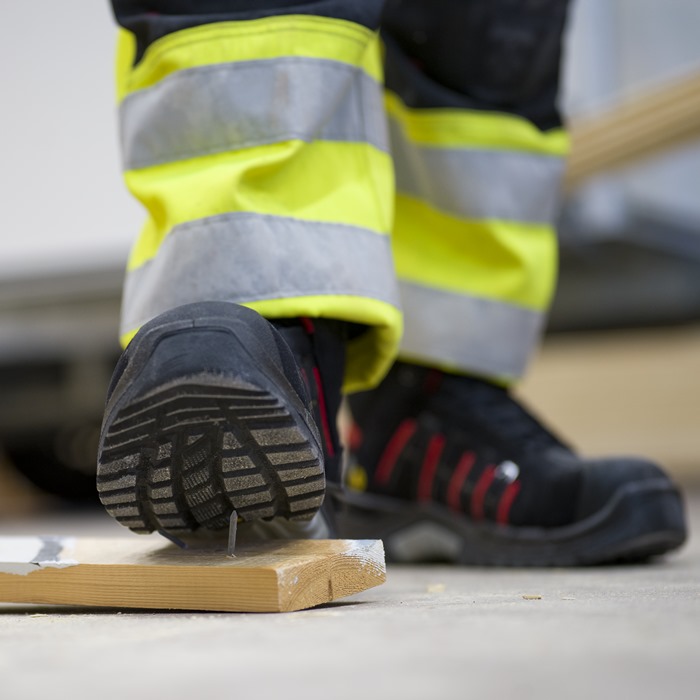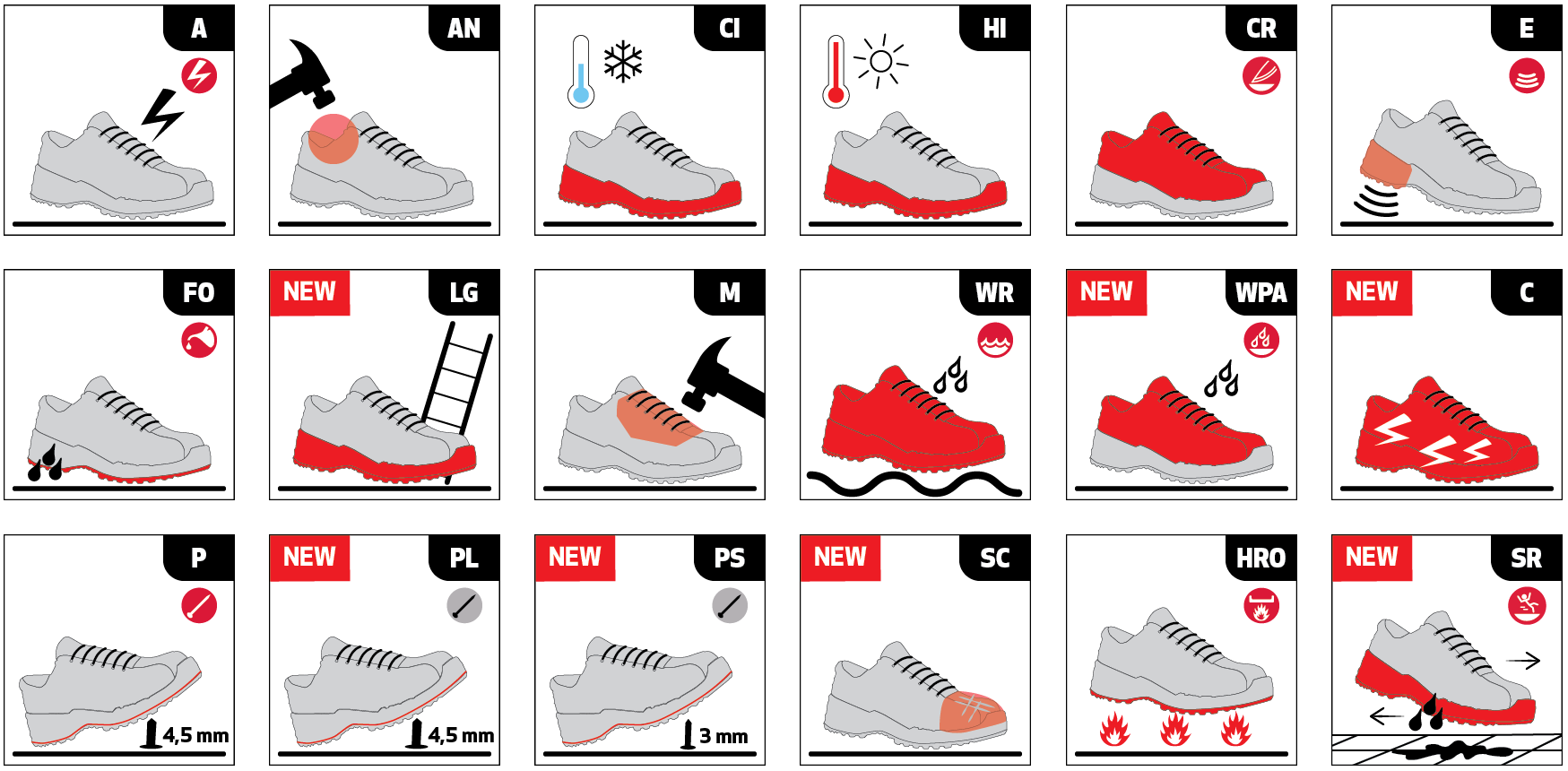What is new in the standard EN ISO 20345: 2022?
The current standard for safety shoes EN ISO 20345: 2012 will be updated and will now instead be EN ISO 20345: 2022. So what is new and what will change? Here is a review of the most important changes point by point.
1. Requirements for non-slip safety
SRA, SRB and SRC disappear. Slip testing similar to SRA will instead be included in the basic requirement for certification and therefore has no special marking.
In addition to the basic certification, you can perform another slip test, which is then marked SR (Slip Resistance).
For shoes with, for example, studs, which in practice can be difficult or impossible to test according to standard, you can mark the shoe with the following symbol: Ø.
The test methods are slightly adjusted to mimic reality better, for example, all slip tests are done on tiles.

2. Requirements for perforation resistance
A shoe fitted with protection for nail penetration has previously had the marking P.
However, that marking does not say what material the nail protection consists of. The new standard clarifies somewhat what material the protection consists of and what size of test nail was used in the tests. A smaller diameter gives a higher pressure and thus higher requirements for protection.
P: Nail protection made of steel with, diameter of test nail 4.5 mm.
PL: Nail protection of "non-metal" with, diameter of test nail 4.5 mm.
PS: Nail protection of "non-metal" with, diameter of test nail 3 mm.


3. Levels of protection
The number of protection levels has increased from SB - S5 to SB - S7 with associated sublevels.
The previous protection levels were divided as follows:
SB, S1, S2, S3, S4 and S5 where SB is the only protection level that allows open heel.
S1 has sometimes been seen with nail protection as an addition and has then been called S1P.
S4 and S5 are so-called class II products (rubber boots).
The new main division is:
SB, S1, S2, S3, S4, S5, S6 and S7.
Protection level S1 will still be visible with the suffix P, ie S1P. However, since the tests for nail protection have been extended to P, PL and PS, the protection level S1 will therefore be able to be specified with these additions; S1P, S1PL and S1PS.
Other protection levels that already includes requirements for nail protection are not stated as before, as the protection level itself already states that the product meets these requirements. However, it is interesting to know what type of nail protection that is included in the product. For example, protection class S3 (requirement for nail protection is included in that protection class) is therefore divided into the following three levels - S3, S3L and S3S.
S3 is tested with a steel nail, S3L "non-metal" nail protection with a large nail (L = Large) and S3S "non-metal" nail protection with a small nail (S = Small). In the same way, the protection levels S5 and S7 are divided, as these protection levels also have requirements for nail protection.

4.Specific requirements
The additional requirements has gone from being 12 to 18. Some have been removed and has instead become a part of the basic certification while others have been added. The new list of 18 possible additional requirements look like this:

Codes and requirements:
PL - Perforation resistance (non metal insert)
PS - Perforation resistance (non metal insert)
C - Partly conductive footwear
A - Anti-static footwear
HI - Heat insulation of outsole complex
CI - Cold insulation of outsole complex
E - Energy absorption of seat region
WR - Water resistance
M - Metatarsal protection
AN - Ankle protection
CR - Cut resistance
SC - Scuff cap abrasion
SR - Slip resistance (ceramic tile floor with glycerine)
WPA - Water penetration and absorption
HRO - Resistance to hot contact
FO - Resistance to fuel oil
LG - Ladder grip
5. Ladder Grip
Previously, "heel grip for ladder" has been included in the standard for shoes intended for firefighters. That part has been copied for a stand-alone additional test for all safety shoes. This makes it possible to test all safety shoes with regard to step grip in the new standard. Please note that this is one of several additional tests that are not mandatory.

6. FO is no longer mandatory
The marking FO refers to the shoe sole's resistance to hydrocarbons (oils, petrol, etc.). This has previously been a mandatory part for protection level S1-S5, ie as soon as you do not have a shoe with an open heel. FO will henceforth be an additional test that can be done for shoes intended for environments with hydrocarbons, where relevant.


7. Water resistance
Two new levels of protection have been added; S6 and S7. What S6 and S7 have in common is that these protection levels have requirements for water resistance (Water-Resistant, marking WR). Otherwise, S6 means the same protection as the requirement for S2 but with additional requirements for water tightness (WR), while S7 is the same as S3 but with additional requirements for water tightness (WR).
An approved shoe with the marking S2 or S3 has according to the "old" standard a water repellent upper (WRU - Water Repellent Upper). However, only the material itself is tested to obtain WRU. When the material is included in a shoe, the shoe as a whole can lose its water-repellent ability because water penetrates into the seams.
In the new standard, the marking WRU disappears, instead we see the marking WPA (Water penetration and absorption) and the marking as already mentioned; WR.
8. Timing
Safety shoes placed on the market after 30 March 2023 must be certified in accordance with EN ISO 20345: 2022. However, safety shoes that are already on the market and whose certificate is still valid do not need to be certified according to the new standard until the certificate has reached its expiry date, even if this falls after March 30, 2023. EU type examination (certificate) has a validity of 5 years. Therefore, for some time to come, we will see products certified according to both new and old standards on the market.
